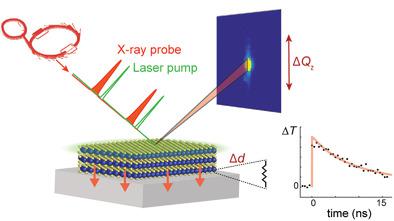当前位置:
X-MOL 学术
›
Adv. Funct. Mater.
›
论文详情
Our official English website, www.x-mol.net, welcomes your feedback! (Note: you will need to create a separate account there.)
Visualizing Energy Transfer at Buried Interfaces in Layered Materials Using Picosecond X‐Rays
Advanced Functional Materials ( IF 19.0 ) Pub Date : 2020-06-30 , DOI: 10.1002/adfm.202002282 Clara Nyby 1 , Aditya Sood 2 , Peter Zalden 3 , Alexander J. Gabourie 4 , Philipp Muscher 5 , Daniel Rhodes 6 , Ehren Mannebach 5 , Jeff Corbett 7 , Apurva Mehta 7 , Eric Pop 4 , Tony F. Heinz 2, 8 , Aaron M. Lindenberg 2, 5
Advanced Functional Materials ( IF 19.0 ) Pub Date : 2020-06-30 , DOI: 10.1002/adfm.202002282 Clara Nyby 1 , Aditya Sood 2 , Peter Zalden 3 , Alexander J. Gabourie 4 , Philipp Muscher 5 , Daniel Rhodes 6 , Ehren Mannebach 5 , Jeff Corbett 7 , Apurva Mehta 7 , Eric Pop 4 , Tony F. Heinz 2, 8 , Aaron M. Lindenberg 2, 5
Affiliation

|
Understanding the fundamentals of nanoscale heat propagation is crucial for next‐generation electronics. For instance, weak van der Waals bonds of layered materials are known to limit their thermal boundary conductance (TBC), presenting a heat dissipation bottleneck. Here, a new nondestructive method is presented to probe heat transport in nanoscale crystalline materials using time‐resolved X‐ray measurements of photoinduced thermal strain. This technique directly monitors time‐dependent temperature changes in the crystal and the subsequent relaxation across buried interfaces by measuring changes in the c‐axis lattice spacing after optical excitation. Films of five different layered transition metal dichalcogenides MoX2 [X = S, Se, and Te] and WX2 [X = S and Se] as well as graphite and a W‐doped alloy of MoTe2 are investigated. TBC values in the range 10–30 MW m−2 K−1 are found, on c‐plane sapphire substrates at room temperature. In conjunction with molecular dynamics simulations, it is shown that the high thermal resistances are a consequence of weak interfacial van der Waals bonding and low phonon irradiance. This work paves the way for an improved understanding of thermal bottlenecks in emerging 3D heterogeneously integrated technologies.
中文翻译:

使用皮秒X射线可视化分层材料中埋藏界面的能量转移
了解纳米级热传播的基础对于下一代电子产品至关重要。例如,已知层状材料的弱范德华键会限制其热边界传导率(TBC),从而产生散热瓶颈。在此,提出了一种新的非破坏性方法,即使用时间分辨的X射线测量的光致热应变来探测纳米级晶体材料中的热传递。该技术通过测量光激发后c轴晶格间距的变化,直接监测晶体中随时间变化的温度变化以及随后在掩埋界面上的弛豫情况。五个不同的层状过渡金属二卤化物MoX 2 [X = S,Se和Te]和WX 2的膜研究了[X = S和Se]以及石墨和MoTe 2的W掺杂合金。在室温下在c面蓝宝石衬底上发现的TBC值在10-30 MW m -2 K -1范围内。结合分子动力学模拟,表明高的热阻是弱的范德华键合和低声子辐照度的结果。这项工作为增进对新兴3D异构集成技术中的热瓶颈的理解铺平了道路。
更新日期:2020-08-19
中文翻译:

使用皮秒X射线可视化分层材料中埋藏界面的能量转移
了解纳米级热传播的基础对于下一代电子产品至关重要。例如,已知层状材料的弱范德华键会限制其热边界传导率(TBC),从而产生散热瓶颈。在此,提出了一种新的非破坏性方法,即使用时间分辨的X射线测量的光致热应变来探测纳米级晶体材料中的热传递。该技术通过测量光激发后c轴晶格间距的变化,直接监测晶体中随时间变化的温度变化以及随后在掩埋界面上的弛豫情况。五个不同的层状过渡金属二卤化物MoX 2 [X = S,Se和Te]和WX 2的膜研究了[X = S和Se]以及石墨和MoTe 2的W掺杂合金。在室温下在c面蓝宝石衬底上发现的TBC值在10-30 MW m -2 K -1范围内。结合分子动力学模拟,表明高的热阻是弱的范德华键合和低声子辐照度的结果。这项工作为增进对新兴3D异构集成技术中的热瓶颈的理解铺平了道路。


























 京公网安备 11010802027423号
京公网安备 11010802027423号